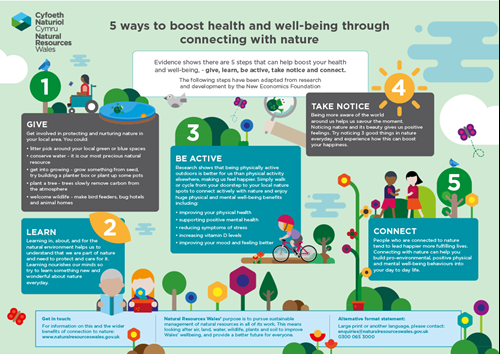Five ways to boost health and well-being through nature

Evidence shows there are five steps that can help boost your health and well-being: give, learn, be active, take notice and connect.
These steps have been adapted from research and development by the New Economics Foundation.
1. Give
Get involved in protecting and nurturing nature in your local area.
You could:
- litter pick around your local green or blue spaces
- conserve water - it is our most precious natural resource
- get into growing - grow something from seed, try building a planter box or plant up some pots
- plant a tree - trees slowly remove carbon from the atmosphere
- welcome wildlife - make bird feeders, bug hotels and animal homes
2. Learn
Learning in, about, and for the natural environment helps us to understand that we are part of nature and need to protect and care for it.
Learning nourishes our minds so try to learn something new and wonderful about nature everyday.
Parents and educators - use our resources to help children learn about the natural environment
3. Be active
Research shows that being physically active outdoors is better for us than physical activity elsewhere, making us feel happier.
Simply walk or cycle from your doorstep to your local nature spots to connect actively with nature and enjoy huge physical and mental well-being benefits including:
- improving your physical health
- supporting positive mental health
- reducing symptoms of stress
- increasing vitamin D levels
- improving your mood and feeling better
4. Take notice
Being more aware of the world around us helps us savour the moment. Noticing nature and its beauty gives us positive feelings.
Try noticing three good things in nature everyday and experience how this can boost your happiness.
5. Connect
People who are connected to nature tend to lead happier more fulfilling lives.
Connecting with nature can help you build pro-environmental, positive physical and mental well-being behaviours into your day to day life.
Find out what your connection with nature is like with our natural progression model
Display this information as a poster
Open a PDF suitable for printing

